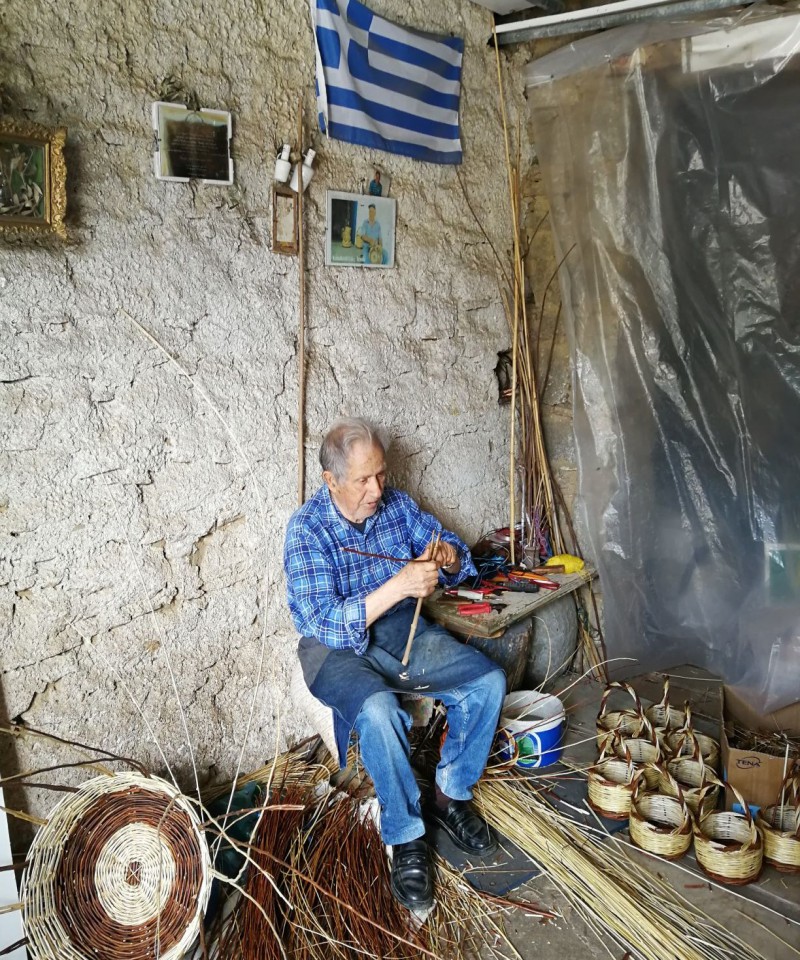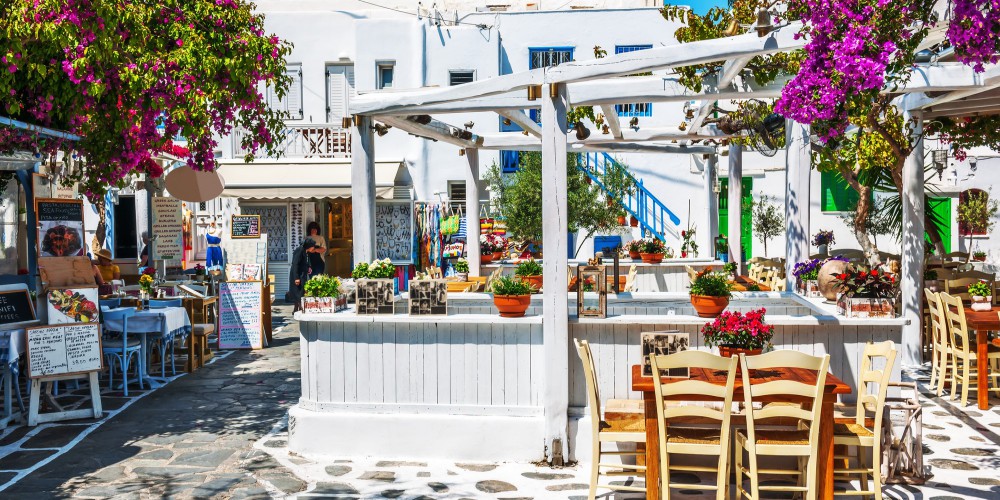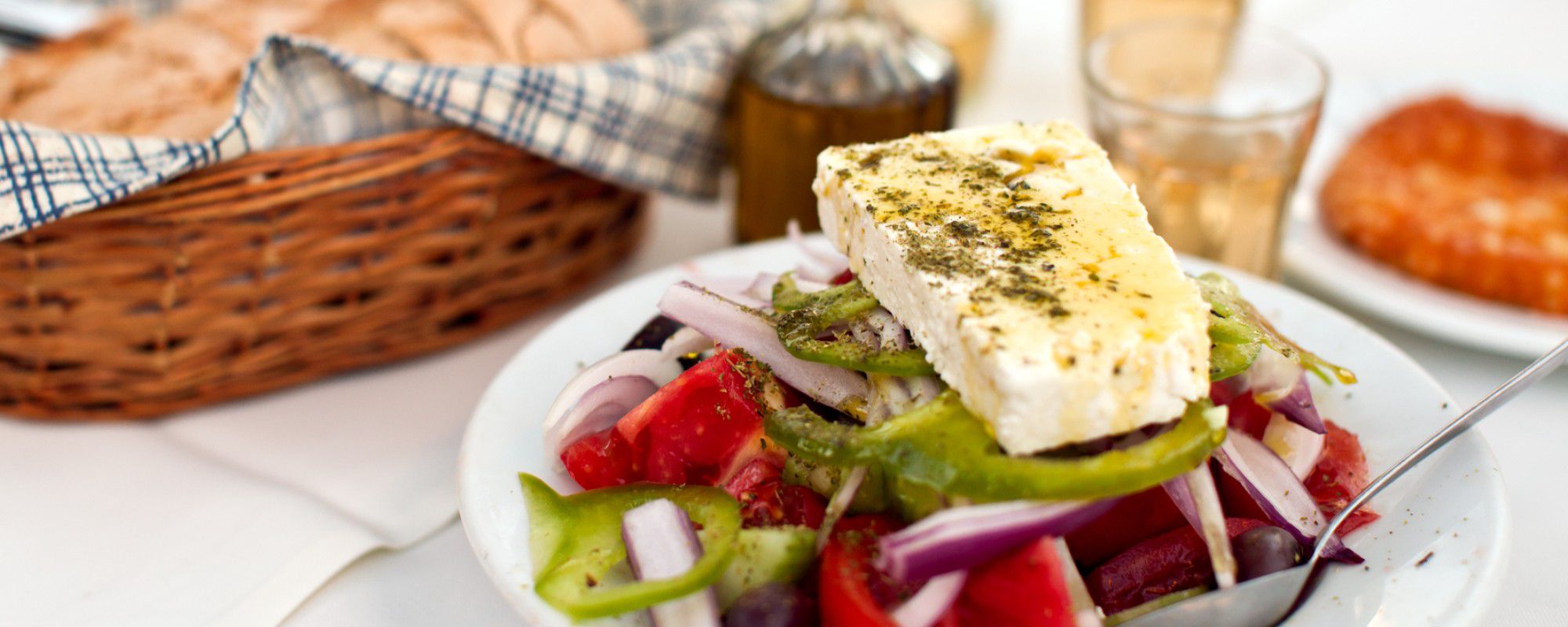
Rhodes Food Guide: Best Restaurants & What to Eat (Updated for 2026)
Key Takeaways
- Rhodes restaurants focus on traditional Greek dishes and exceptional service that accurately represents Greek hospitality.
- The island offers fresh seafood, including octopus, calamari, and sea bass.
- Local specialties include pitaroudia (chickpea fritters) and melekouni (sesame-honey treat).
- Rhodes features local wines from the Embonas region and high-quality olive oil.
According to Greek Mythology, when the island of Rhodes emerged from the water, the god Helios -the god of the sun- asked Zeus to give it to him as his share of the world.
That’s how Helios became the patron god of the island and gave it the name of his beloved: Rhodes. And that’s why the ‘emerald island,’ as it has been nicknamed, attracts with its incomparable beauty thousands of visitors from all over the world.
Apart from the striking landscapes, fascinating sights, labyrinthine alleys, and sandy beaches, the diverse, cosmopolitan island will amaze you with its rich culinary heritage.
There is no possibility that during the summer months in the scenic villages, the locals won’t welcome you with all sorts of goodies, from snacks accompanied by souma -a local spirit similar to tsipouro- or wine of their own production to their own handmade dishes and a cup of traditional Greek coffee.
In this Rhodes food guide, we’ll dive deep into a thorough exploration of the island's local cuisine and the wide range of tastes it offers so you can make sure not to miss any of its traditional Greek food during your visit. Mark my words: you may come to Rhodes for the history and the beaches, but you’ll be staying for the food and Rhodes restaurants.
Taste the Local Products of Rhodes; an Ode to Greek Food

The opulence of the Greek land has become famous across the world throughout the years. The island of Rhodes is, of course, no exception to the rule, enriching the lives of its locals -and Greeks in general- with delectable and -mostly- nutritional offerings one cannot resist.
Rhodes' products intertwine with the island's history and culture. Local honey and types of pasta, traditional jams, and PDO wines make up the traditional gastronomic treasure.
The mainstay of Rhodian cuisine is mainly the three stars of the Mediterranean diet - wheat, olives, and wine, followed by legumes and dairy products.
Utilizing the above materials has produced foods that are particularly popular on the island, such as groats and different types of pasta made from wheat. In combination with other raw materials straight from the fertile Rhodian land, they have created simply nutritious and tasty dishes in the local cuisine.
One thing that needs to be highlighted is that the main feature of Rhodes cuisine is the excessive use of cumin, which is not common in the rest of Greece -not to that extent at least.
Among my favorite flavors of Rhodes are the local mizithra cheese (oh yes, feta cheese has been betrayed), the wide selection of olive oils, the pickled caper leaves, the fresh olive oil, and the rich local honey. Yes, you can find these products all across Greece, but the varieties you can find in Rhodes are delectable and definitely worth a try.
Of course, one cannot speak about the local products and fail to mention the popular -yet significantly less nutritious- souma.
Often referred to as ‘Rhodian raki’ or ‘Rhodian tsipouro,’ souma is a traditional grape distillate that, with its distinct aroma, flavor, and pureness, has managed to become the most beloved drink of the locals, who offer it to the visitors of Rhodes as a gesture of goodwill every chance they get.
It is one of the “cleanest” alcoholic drinks you can find as it has no preservatives inside it or anything else that is harmful to the body. A taste of souma will bring you closer to the folk culture of the island while, at the same time, it will be the perfect spark plug for your mood!
Savor the Local Cuisine of Rhodes
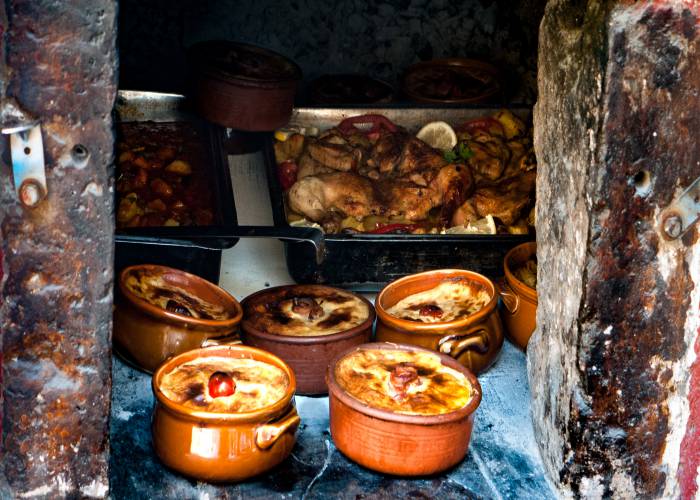
Quite a few dishes of the local cuisine have survived from the olden times to this day. Those few are packing a punch in the flavor department leaving everyone who tastes them drooling and asking for more. Here are the traditional dishes of Rhodes grouped in categories for your convenience.
-
Starters
Avranies: A local variety of asparagus found in the wild, cooked in a pan with olive oil and onions and drizzled with flour and lemon sauce.
Pitaroudia: One of the most popular Rhodian delicacies, pitaroudia are pies made of pureed boiled chickpeas that are mixed with plenty of finely chopped mint, onions, and tomato, formed into balls, and baked in hot oil.
Voloi me pligouri: A local appetizer that consists of bulgur mixed with minced meat and tomato.
Karavoloi: Not for everyone and definitely not for the less adventurous eaters, karavoloi are snails cooked in olive oil with onion, tomato, fresh pepper, bay leaves, and lots and cumin.
Chtapodokeftedes: A personal favorite but yet again a dish that requires an open-minded approach, chtapodokeftedes are octopus meatballs that consist of minced octopus with loads of herbs boiled in hot oil and served with love. Yum.
-
Main dishes
Matsi: Definitely at the top 3 of Rhodes’ most popular dishes, matsi is a type of handmade pasta cooked in meat stock instead of water and enriched with lots of cheese and butter. Not light on the calories but definitely delicious, matsi pasta can be served with lentils, chickpeas, or even beans.
Koulouria: again, a type of pasta that is thickened with loads of grated cheese, and it is the traditional food Rhodes’ weddings and other types of official celebrations.
Tsouka: it is an easy Rhodian veal recipe that includes trahana -typical Greek pasta- and bulgur cooked in the casserole. Tsouka is traditionally made with goat meat and is truly one of the most delicious dishes the Rhodians serve at their family tables. The crisp crust that forms on the top of the pot is simply to die for!
Ornitha me loukoumi: ‘ornitha’ means ‘chicken’ in Greek, and therefore ornitha me loukoumi is a chicken dish consisting of rice, giblets, onions, and herbs, which is traditionally served with local chylopites - an egg-based homemade pasta that is also referred to as ‘loukoumi.’
Lakani: is a local dish that refers to the kitchenware it is cooked in, which the ceramic lidded pot also known as lakani. This delicious dish consists of veal, goat or lamb meat slow-cooked in tomato sauce inside a traditional wood oven and served with roughly-ground wheat or chondros.
-
Dessert
Melekouni: If you’ve been to Rhodes, then you’ve definitely heard of melekouni; it looks like an almond brittle, but it is not exactly the same in taste and texture. Melekouni is the traditional dessert of the Rhodians for all celebratory events, such as engagements, weddings, births, baptisms, and nominal feasts.
It has a soft yet sturdy texture, and its main composition consists of roasted sesame, honey, almonds, cinnamon, and nutmeg. Depending on the season, the mixture is also flavored with orange, tangerine, or bergamot peels.
Moschopougia: Another acclaimed dessert of Rhodes is moschopougia, the sweet pie that in Greek literally translates to ‘good-smelling pouches’ locals go nuts for.
These small, heavenly pies are filled with ground nuts -mostly, but not only, almonds-, nutmeg, and sugar, and are also drizzled with rosewater. They are as good as they sound, if not better!
Takakia: also known as madinades, takakia are pastries filled with ground nuts, nutmeg, cinnamon, and clove and coated in olive oil and honey. They are a very special treat with only a minimal amount of sugar and a high nutritional value thanks to the alimental ingredients they contain.
This local dessert is very reminiscent of baklava, so if you like the oriental sweet, you’re going to love takakia!
Tahinopita: Tahini is an integral ingredient of Rhodes cuisine and is used in various ways, even as a fish sauce or in various pastries and types of bread.
Tahinopita is a small tahini pie that, once it gets cooked, is then coated with a mixture of tahini, sugar, cinnamon, and cloves and wrapped in a roll.
Those tahini rolls can be found in various places around Greece and Cyprus, but if you get the opportunity to try them in Rhodes, don’t think twice; tahinopita will change the way you think of tahini forever.
The list above includes most, but not all, of the local dishes of Rhodes island, as they are too many and with too many variations depending on the region of the island you happen to try them in.
However, these are my top picks that will give you a comprehensive guide during your exploration of Rhodes’ gastronomy and will help you incorporate the most delicious Rhodian flavors into your holiday diet.
What’s more, you can experience homemade goodies of Greek cuisine by joining a cooking class in Rhodes that will provide you with the best local recipes and the skills to recreate them from the comfort of your own home!
Accompany the traditional Greek food with Rhodes' wine varieties

It is a well-known fact that in Greece, wine is integrated into the heritage and culture of the locals and has been since antiquity. Although the art of winemaking has evolved over the years, its roots remain the same, as do the traditions and customs that go with it.
Rhodes was one of the first Aegean islands to ever excel in winemaking, becoming the greatest trader of wine during the 7th century BC, something that was surely a result of the island being the naval center of the region.
Although the random vineyard can be found across all the islands of the Dodecanese complex, only Rhodes and, in recent years, Kos have established themselves as strong cards in the wine-making industry. For the most part, Rhodes’ vineyards are located either in the basin of the island or on the slopes of Mount Atavyros.
The Rhodian vineyards are favored by the unique climate of the island, which is defined by bright sunshine, relatively frequent rain, and cool sea breezes that manage to keep the temperatures at a moderate level from May to September.
If you care about specifics, annually, the rainy days are no more than 70, while the average temperature comes up to 19 degrees Celsius - absolutely perfect both for living and winemaking.
The harvest takes place during the early morning hours over a seven-day period. It starts in the second half of August for the white varieties and around the beginning of September for the red varieties.
In Greece, 28 wine varieties are entitled to PDO (Protected Designation of Origin), of which two can be found in Rhodes. The PDO Rhodes white wine is produced from at least 70% of the grapes of the Athiri variety and the remaining 30% from the Malagouzia and Assyrtiko varieties.
The Athiri variety has been popular on the island since antiquity. It has a very low yield, a fresh fruity taste and a mild aroma. The PDO Rhodes red wine is produced from at least 70% of the grapes of Amorgiano, while the remaining 30% consists of the Mavratheriko variety.
Amorgiano is a rare variety of red grapes that grows in the Aegean islands and Crete. The rosé wines it produces are distinguished for their fruity, delicate aroma, while the red wines are characterized by their richness, volume, and spicy notes.
Additionally, Rhodes island holds the position of the leading supplier of Greek sparkling wines that are known for their ease of consumption as they combine fruity notes with a crispness and freshness no lover of wine can resist.
It is no coincidence that some of the sparkling rosé varieties have been characterized as the best sparkling wines in the Mediterranean.
Enjoy the incredible Rhodes restaurants
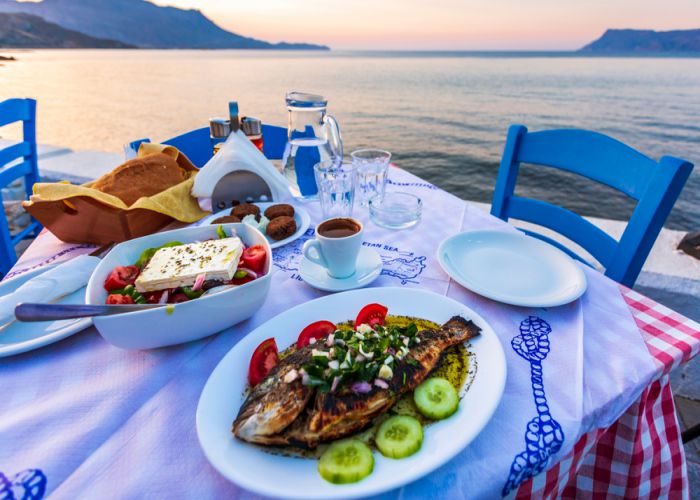
In recent years, Rhodes’ local gastronomy -which suffered a decline in the recent past- has been dynamically brought back to the forefront, transforming into one of the strongest elements of the island that lures visitors in.
After all, it’s worth highlighting that the southern part of the Aegean was declared ‘Europe's Gastronomic Region 2019’, enhancing the reputation of the island and attracting foodies from all over the world.
The many Rhodes dining establishments, some of which can be found along Rhodes' beaches, offer not only delectable traditional dishes that follow age-old recipes that have been passed down through generations but also take traditional elements and incorporate them into contemporary flavor combinations and new cooking techniques.
An increasing amount of eating establishments have gone back to their roots, resorting to local ingredients taken fresh from the Rhodian land, realizing that originality combined with tradition can add value to a destination. From a noble gourmet restaurant to a family tavern, you'll find everything you're looking for!
Among the plethora of options, we have distinguished a few restaurants and taverns that managed to sweep me off my feet with their mouthwatering flavors and creative concoctions.
Starting with the high-end options, Botrini’s Rodi, a noble gourmet restaurant. Housed within the luxurious Bellevue Suites restaurant, famous Greek chef Hector Botrini's award-winning cuisine follows the well-known paths of tradition, spicing them up with modern twists.
In the summertime, its outdoor dining room is a stone-built courtyard around an old refurbished mill. There you can try inspirational dishes such as a kid roasted in the oven with wild mushrooms and aromatic herbs, calf with sweet wine and spices, shrimp in kantaifi crust, and goat milk ice cream, among others, and experience fine dining at its best!
Noble is another favorite meeting place for the island's gourmands. Located in the main building of the hotel Elysium Resort & Spa, where culinary tradition is approached in an innovative and unconventional way.
Enjoy a warm plate of cod soup and zucchini, fresh fish and meat cooked traditionally, and local sweet treats that will capture your senses in one of the best Rhodes restaurants that showcase the Mediterranean diet.
A lot more humble but just as good, Rhodes’ local taverns are the true star of the island’s culinary scene.
At the beach of Kolimbia, next to the sea in a beautiful, hospitable place, To Nisaki is an ideal choice for those who love fine fisheries. Since 1954 it has been serving with passion and professionalism delicious and fresh seafood dishes brought daily by local fishermen, freshly cut salads, and appetizers of excellent raw materials combined with ouzo or a cold glass of beer!
Next to running waters and enclosed by luscious trees, the family-run tavern of Pigi Fasouli serves traditional Greek dishes with olive oil, Greek salad, local meats, and unique home-cooked casseroles that will leave you speechless due to their authentic taste.
Located in the village of Psinthos, Pigi Fasouli is one of the locals’ best-kept secrets -well, until now. Try the traditional fried chickpea balls and the oven-cooked stuffed with rice and spices, and you’ll understand our enthusiasm! Not to mention that Psinthos is a historic Rhodes village that attracts crowds for its undeniable beauty.
Last but definitely not least, Lindos may be about 55 kilometers from Rhodes town, but it hides within its region local treasures the locals of Rhodes apprize. Mavrikos is one of them.
It is one of the most renowned Rhodes restaurants on the island, housed in a neoclassical building in the center of Lindos Main Square since its establishment in 1933.
Its award-winning Greek cuisine has a purely Greek vibe that is showcased in its flagship dish, the famous soupiorizo, a rice soup made with cuttlefish ink. Rest assured that whatever you choose from the menu, your tastebuds will thank you for it!
Keep in mind that in addition to Rhodes' traditional food being served in local restaurants in Rhodes Town and beyond, you can find delectable offerings on the island’s local markets that are held ever so often and gather large crowds of both visitors and residents looking for a good relaxing time!
As a matter of fact, if you’re looking for a truly original Rhodian taste and local feeling, food markets are your best bet, and therefore, you should make a point of visiting one during your stay if possible.
On Wednesdays and Saturdays, the food market is held in Agios Dimitrios near Rhodes Town, near the area of the local graveyard. On Thursdays, you can locate the local food market on Vyronos street, where the Diagoras football field is located. Lastly, on Fridays, you can browse the food stalls of the market on Constantinos Ydraios street in the area of Analipsis.
Final Thoughts
Ottoman Turks, Venetians, Franks, and even the Italians, in the first half of the 20th century, have left their mark on not only Rhodes Town but also on what we call today 'Rhodian flavors.' Anyone who has tasted this world-renowned Greek food at least once in their lifetime doesn’t need any more reasons to visit Rhodes again and again!
Walking around Rhodes town is not enough to appreciate the island. With this Rhodes food guide as your guideline, explore the gastronomy of Rhodes and eat your way to culinary heaven!






